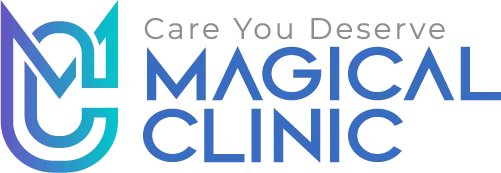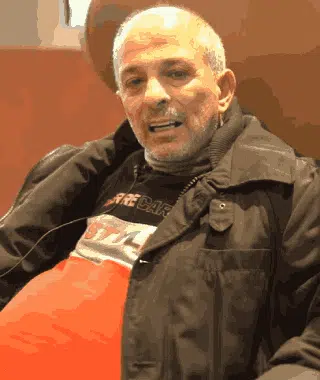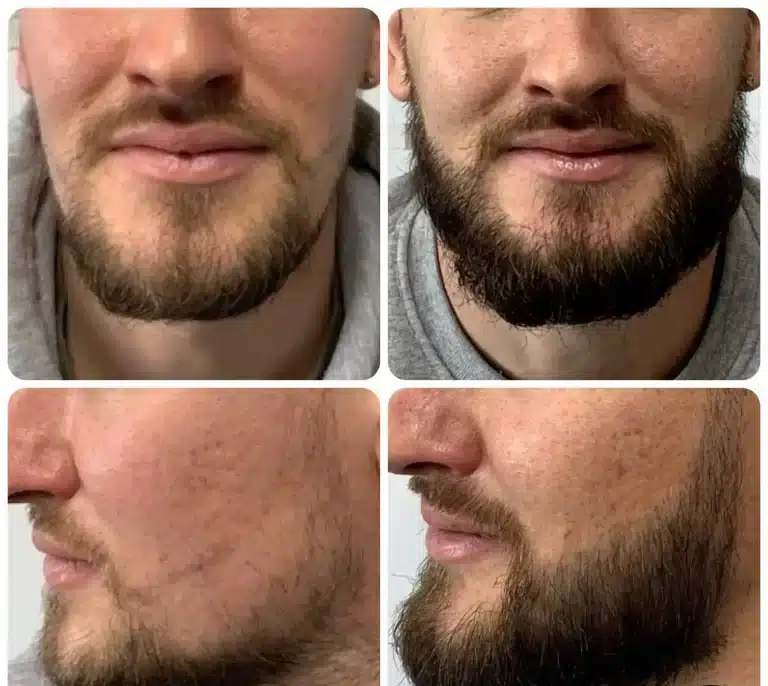
Table of Contents
Beard Transplant in Turkey: A Complete Guide to Restore Your Facial Hair with Confidence
A full, well-shaped beard has become a strong symbol of masculinity and style—but not all men can grow one naturally. Whether due to genetics, scars, or medical conditions, patchy or thin facial hair can be frustrating. That’s why more and more men are turning to beard transplant in Turkey as a lasting solution.
Turkey is now a global hotspot for beard restoration, offering high-quality treatment at affordable prices. With experienced surgeons, modern clinics, and impressive results, it’s no surprise that thousands choose Turkey each year for their transformation. In this guide, we’ll explore everything you need to know—types of procedures, costs, benefits, and how to choose the right clinic.
What is Beard Transplant in Turkey?
A beard transplant in Turkey is a cosmetic procedure where hair follicles—usually from the back of the scalp—are extracted and transplanted into the beard area to improve density and shape. It’s performed under local anesthesia and uses advanced techniques to ensure natural, long-lasting results. Turkey is known for its high standards in hair restoration and has become a top destination for beard hair transplants.
Time in Turkey
7 to 14 days
Surgery Time
2 to 5 hours
Hospital Stay
1 to 3 days
Recovery
2 to 6 weeks
Accomodation
4/5* Hotels
Transportation
Private Driver
Types of beard transplant in Turkey
If you’re considering a beard transplant in Turkey, it’s important to understand the different techniques available. Each method has its own benefits, depending on your goals, hair type, and facial structure. Knowing how each procedure works will help you make an informed decision and discuss the best option with your surgeon. Let’s take a closer look at the most common types of beard transplants used in Turkey.
FUE (Follicular Unit Extraction)
This method involves extracting individual hair follicles from the donor area and implanting them in the beard region. It’s the most common technique used in beard transplant Turkey clinics due to its precision and minimal scarring.
DHI (Direct Hair Implantation)
A more advanced technique, DHI uses a special implanter pen to insert the grafts directly into the beard without creating recipient incisions. This results in faster healing and a denser, more natural look.
How is the Beard Transplant Procedure Done in Turkey?
A beard transplant is a cosmetic procedure designed to restore or enhance facial hair in areas where growth is patchy, thin, or absent. In Turkey—one of the world’s top destinations for hair restoration—the procedure is performed by expert surgeons using advanced techniques, especially FUE (Follicular Unit Extraction). The entire process typically takes 4 to 8 hours and delivers natural-looking results. Here’s a step-by-step breakdown of how it works:
1. Initial Consultation and Facial Assessment
Before the procedure, you’ll meet with a specialist to assess your beard goals and donor area suitability. During this session:
■ The surgeon examines your facial structure and hair growth pattern
■ Photos may be taken for planning and simulation
■ A personalized beard design is created
■ Your donor area (usually the back of the scalp) is evaluated for follicle density
2. Preparation and Local Anesthesia
On the day of the surgery:
■ The treatment areas (donor and recipient) are cleaned and shaved if necessary
■ Local anesthesia is applied to ensure a pain-free experience
■ You’ll remain awake but comfortable during the entire procedure
3. Follicle Extraction (FUE Method)
Using the FUE technique, individual hair follicles are extracted from the donor area with a micro punch tool:
■ No linear scars
■ Minimal discomfort
■ Typically 2,000 to 5,000 follicles are harvested depending on the beard density desired
4. Graft Sorting and Preparation
Extracted follicles are carefully sorted and prepared under a microscope:
■ Grafts are separated based on the number of hairs per unit
■ Only strong, healthy follicles are selected for implantation
5. Implantation into the Beard Area
This is the most delicate part of the procedure. The surgeon uses fine tools to implant each graft at the correct angle, depth, and direction to mimic natural beard growth:
■ Beard shape is designed based on your preference (goatee, full beard, etc.)
■ High attention to detail ensures symmetry and density
■ The process can take several hours depending on the number of grafts
6. Post-Procedure Care and Healing
After the transplant:
■ Mild redness, swelling, or scabbing may occur and fade in a few days
■ Special shampoos and aftercare products are provided
■ Tiny scabs fall off in 5–10 days
■ Transplanted hairs may shed in 2–4 weeks—this is normal
■ Permanent growth begins around 3 months, with full results visible in 6 to 12 months
Why is Turkey a Popular Destination for Beard Transplant?
Turkey is a global leader in cosmetic hair restoration, known for its skilled surgeons, advanced techniques like FUE and DHI, and state-of-the-art clinics. The country offers high-quality care at a fraction of the cost compared to Western nations, with all-inclusive medical packages covering accommodation and post-op care. With short waiting times, high success rates, and natural-looking results, Turkey remains a top destination for hair transplants:
World-Class Surgeons
Turkey boasts internationally trained specialists who perform thousands of procedures annually. They use the latest techniques like FUE and DHI with precision.
Affordable Pricing
The beard transplant cost in Turkey is significantly lower than in Europe or the US, making it accessible to a broader audience.
High-Quality Clinics
Clinics in Istanbul, Ankara, and Antalya are equipped with modern technology and meet international medical standards.
Medical Tourism Packages
Many clinics offer packages that include airport transfers, hotel stays, translators, and aftercare—all for one transparent price. This makes the process seamless for international patients.
Befor & After Beard Transplant in Turkey
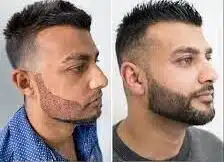
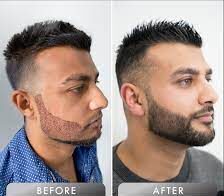
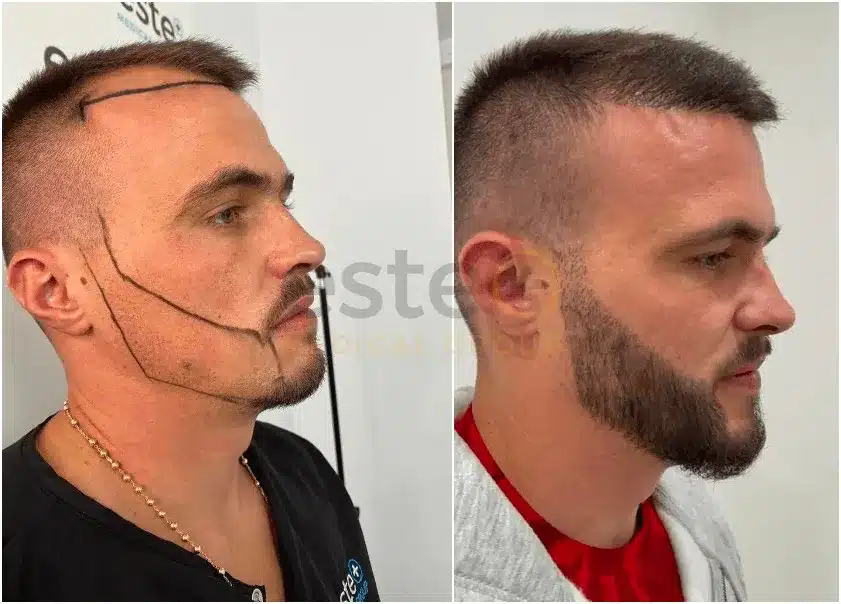

Beard Transplant in Turkey Cost vs. Other Countries
Turkey has become a leading destination for beard transplants, offering high-quality procedures at competitive prices. With experienced surgeons, advanced techniques, and affordable packages, many patients from around the world choose Turkey over other countries. Compared to Europe and the U.S., where costs can be significantly higher, Turkey provides excellent results at a fraction of the price. This combination of affordability and expertise makes it a top choice for those seeking a fuller, natural-looking beard.
Country | Average Cost (USD) |
Turkey | $1,200 – $2,500 |
USA | $6,000 – $10,000 |
UK | £4,000 – £7,000 |
Germany | €5,000 – €8,000 |
UAE | $5,000 – $9,000 |
Turkey offers the most competitive beard transplant in Turkey price globally without compromising on quality.
Choosing the Right Clinic and Surgeon for Beard Transplant in Turkey
Turkey has become one of the top destinations for beard transplants due to its affordable prices, high-quality medical services, and experienced surgeons. However, with numerous clinics offering the procedure, it is essential to choose the right one to ensure safe and successful results. Here are the key factors to consider when selecting a clinic and surgeon for a beard transplant in Turkey.
1. Check the Clinic’s Accreditation and Certification
Ensure that the clinic is licensed and accredited by reputable health organizations, such as the Turkish Ministry of Health or the Joint Commission International (JCI). Accreditation ensures that the clinic follows strict safety and hygiene standards.
2. Evaluate the Surgeon’s Credentials and Experience
■ Verify the surgeon’s medical qualifications and certifications.
■ Check how many years of experience they have in hair and beard transplantation.
■ Look for before-and-after photos of previous patients to assess the quality of their work.
3. Read Patient Reviews and Testimonials
■ Look for authentic patient reviews on Google, Trustpilot, and clinic websites.
■ Consider both positive and negative feedback to get a balanced perspective.
■ Join online forums or social media groups to ask for personal experiences.
4. Understand the Techniques Used
The most common techniques for beard transplantation are: ■ FUE (Follicular Unit Extraction): A minimally invasive technique that involves extracting individual hair follicles and implanting them in the beard area.
■ DHI (Direct Hair Implantation): A more advanced technique that offers better precision and density.
■ Ask the surgeon about the best technique for your specific needs.
5. Compare Pricing and Packages
■ While Turkey offers affordable beard transplants, avoid choosing the cheapest option without considering quality.
■ Many clinics provide all-inclusive packages that cover accommodation, transportation, and post-operative care—compare these offers.
5. Assess the Clinic’s Hygiene and Facilities
■ Visit the clinic if possible or request a virtual tour.
■ Ensure that the clinic maintains high standards of cleanliness and uses modern equipment.
6. Understand the Post-Operative Care and Follow-Up Services
■ A reliable clinic should provide clear aftercare instructions and support.
■ Check if the clinic offers follow-up consultations to monitor your progress.
7. Verify Transparency and Avoid Hidden Costs
■ Request a detailed breakdown of costs before making a decision.
■ Ensure there are no hidden fees or unexpected charges after the procedure.
How to Book Beard Transplant Procedure in Turkey
Booking a beard transplant in Turkey is a simple, streamlined process that caters specifically to international patients. Thanks to Turkey’s world-renowned cosmetic surgery clinics and professional medical tourism services, arranging your procedure from abroad is easier than ever. Here’s a step-by-step guide to help you navigate the process with confidence:
Step 1: Research Trusted Clinics
Start by researching top-rated clinics in cities like Istanbul, Ankara, or Izmir, known for their expertise in hair and beard transplantation.
Look for clinics that:
■ Specialize in FUE or DHI beard transplant techniques
■ Have board-certified surgeons with experience in facial aesthetics
■ Offer before-and-after galleries and verified patient reviews
■ Are transparent about pricing and package details
■ Provide support for international patients (language assistance, airport pickup, etc.)
Step 2: Request a Free Online Consultation
Most reputable clinics offer free virtual consultations via WhatsApp, email, or video call. During the consultation:
■ You’ll be asked to send photos of your beard area and donor area (back of your head)
■ A medical advisor or surgeon will assess your suitability for the procedure
■ You’ll discuss your beard goals—full beard, goatee, mustache, etc.
■ The clinic will explain the technique (FUE or DHI) and expected number of grafts
Step 3: Receive a Treatment Plan and Quote
After your consultation, the clinic will send:
■ A personalized treatment plan with an estimated graft count
■ A fixed-price quote—often all-inclusive of:
■ Procedure
■ Hotel stay (3–4 nights)
■ Airport transfers
■ Post-op medications
■ Translation services
■ Optional VIP services or upgraded accommodations
Compare quotes and treatment details from 2–3 clinics to make an informed decision.
Step 4: Confirm Your Booking
Once you’ve chosen your clinic:
■ Select your preferred surgery date
■ Pay a small deposit if required to secure your booking
■ Share your passport details for travel and hotel arrangements
■ Receive detailed travel instructions and your confirmed itinerary
Some clinics may also help with visa guidance depending on your nationality.
Step 5: Travel to Turkey for the Procedure
When you arrive in Turkey:
■ You’ll be picked up at the airport by a clinic representative
■ You’ll have a pre-op consultation and hairline/beard design session
■ The procedure will be performed (typically takes 6–8 hours)
■ Post-op care instructions will be provided, and you’ll return for a check-up the next day
Most beard transplant patients stay in Turkey for 2–4 days, depending on the recovery protocol.
✅ Bonus Tips:
■ Wear loose, button-down shirts on surgery day to avoid touching the beard area afterward
■ Ask for a written aftercare guide and list of do’s and don’ts
■ Inquire about online follow-ups after you return home
Benefits of Beard Transplant
A beard transplant in Turkey isn’t just about aesthetics—it’s a complete transformation. Here are the key benefits:
1. Natural and Permanent Results
The transplanted hair follicles are your own, meaning they’ll grow just like the rest of your facial hair. Once the healing process is complete, the results are natural-looking and permanent.
2. Boost in Self-Confidence
A fuller beard can dramatically enhance facial features and give a more masculine appearance. Many men report a significant boost in confidence and self-image after their beard transplant in Turkey.
3. Customizable Beard Style
Whether you’re aiming for a full beard, goatee, or designer stubble, your transplant can be tailored to suit your style. Surgeons design the shape and density according to your preferences and facial structure.
4. Scar-Free Technique
With FUE and DHI methods, there’s minimal scarring, making the procedure highly discreet. No one will know you’ve had a transplant unless you tell them.
5. Quick Procedure and Recovery
The surgery usually takes 4–8 hours depending on grafts needed. Recovery is fast, with most patients resuming daily life within a few days.
6. High Success Rate
With experienced Turkish surgeons and state-of-the-art clinics, the success rate of beard hair transplant Turkey procedures is impressively high.
Risks and Potential Side Effects
While beard transplant in Turkey are generally safe, there are some risks and side effects to consider:
1. Temporary Swelling and Redness
Most patients experience minor swelling or redness around the transplanted area. This usually subsides within a few days.
2. Infection and Scarring
Though rare, infections can occur if post-op care isn’t followed. Choose a licensed clinic with good hygiene practices to minimize this risk.
3. Uneven Growth or Patchiness
In some cases, hair may grow unevenly, especially if the patient doesn’t follow proper aftercare. A touch-up session may be required to correct this.
4. Shock Loss
It’s normal for the transplanted hairs to fall out within a few weeks. Don’t panic—this is part of the growth cycle. New, permanent hairs will start to grow in 3–4 months.
Pre-Surgery Preparations
Getting a beard transplant in Turkey is an exciting step toward achieving the facial hair you’ve always wanted, but like any medical procedure, preparation is key to a smooth experience and the best possible outcome. Proper pre-surgery preparations ensure that your body is ready, risks are minimized, and your surgeon has everything needed to perform the procedure successfully.
1. Initial Consultation and Evaluation
Before anything else, you’ll have a consultation—either in person or virtually—with your chosen clinic. During this session, the surgeon will assess your facial structure, skin condition, and donor area (usually the back of your scalp). You’ll also discuss your desired beard style and density, which helps the surgeon determine how many grafts will be needed and which method (FUE or DHI) is most suitable for you.
2. Medical History and Tests
You’ll be asked about your medical history, any current medications, allergies, or underlying health conditions. Some clinics may perform basic blood tests to rule out infections or other health risks. This is a routine part of the process and ensures that you’re a safe candidate for surgery.
3. Instructions Before Surgery
Your clinic will provide you with a list of pre-operative instructions, which usually include the following:
- 1. Avoid Blood Thinners: Medications such as aspirin, ibuprofen, and certain supplements (like vitamin E or fish oil) should be stopped several days before surgery, as they can increase the risk of bleeding.
- 2. No Smoking or Alcohol: You should avoid smoking and alcohol for at least 48–72 hours before the procedure, as these can interfere with blood flow and healing.
- 3. Hair and Face Washing: You may be instructed to wash your hair and face thoroughly with a specific shampoo or antiseptic cleanser the night before and the morning of the surgery.
- 4. Eat a Light Meal: On the day of surgery, a light breakfast is usually recommended unless your surgeon instructs you otherwise.
- 5. Wear Comfortable Clothing: Opt for a button-up or zip-up shirt to avoid pulling clothes over your head after surgery.
- 6. Plan for Recovery: Arrange transportation if needed, especially if you’ve traveled from abroad. Some clinics include hotel and transfer services as part of their package.
4. Mental Preparation
Although beard transplant in Turkey are minimally invasive and relatively low-risk, it’s still helpful to mentally prepare for the process. Make sure to ask all your questions during the consultation, understand what to expect, and feel confident in your decision.
How Long Do the Results Last?
One of the most common and important questions people ask before getting a beard transplant in Turkey is: “Are the results permanent?” The answer is yes—a beard transplant offers long-lasting, often permanent results, provided the procedure is done correctly and post-operative care is followed properly.
After the transplant, the newly implanted hair follicles go through a natural shedding phase, which usually occurs within the first 2 to 4 weeks. This is completely normal and part of the hair’s natural growth cycle. Following this, the follicles enter a resting phase before beginning to grow again. Most patients start to notice new beard growth around the 3-month mark, with full results typically visible after 6 to 12 months.
Once the transplanted follicles take root and begin to grow, they will behave just like your natural facial hair. You can shave, trim, and style them as you would with any regular beard. Because the hair is harvested from the back of your scalp—an area genetically resistant to balding—it retains those characteristics even after being transplanted to the beard area. This means the hair is strong, stable, and continues to grow for life.
However, long-term success also depends on your overall health, lifestyle, and whether you follow your surgeon’s aftercare instructions. Poor post-op care, smoking, or skin infections can potentially affect the final outcome.
In short, with a skilled surgeon, proper technique, and good care, a beard hair transplant can deliver natural, full, and permanent results—giving you the freedom to enjoy your new look for years to come.
FAQs About Beard Transplant in Turkey
Is a beard transplant painful?
It’s performed under local anesthesia, so pain is minimal.
When will I see the final results?
Final results are visible after 6–12 months.
Can the beard be shaved after the transplant?
Yes, but wait until your surgeon gives the green light—usually after 4 weeks.
Will the donor area look thin?
No, hair is taken from areas where it won’t be noticeable.
Are the results permanent?
Yes, the transplanted hair grows like normal beard hair.
What if the beard grows unevenly?
You can get a follow-up session to even it out.
Do I need time off work?
Most people return to normal life within 3–5 days.
Can I choose my beard style?
Absolutely! Your surgeon will design your beard with you.
Will I have scars?
- No visible scarring if FUE or DHI techniques are used.
